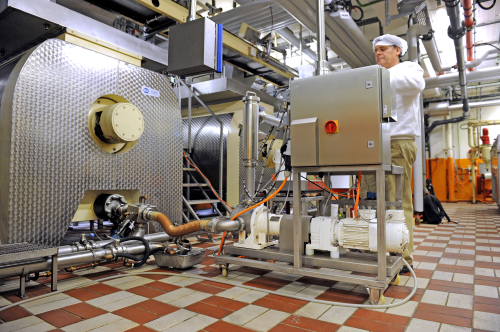
The digital edition of the magazine is distributed free of charge to readers who meet our qualifying criteria. You can apply to receive your free copy by completing this short registration form.
The Kessko factory in Bonn, Germany is using four MasoSine SPS series pumps to help deliver high quality ‘sweet’ products to customers in the bakery, confectionary, ice cream, biscuit and soft drink trades. At the heart of this effort, the SPS pumps offer reliable service that includes the transfer of up to two tonnes of hazelnut spread (containing soft solids) every 60 minutes.
Inside the production hall, one of Kessko's 180 employees enters the exact weight of 12.5 kg of hazelnut spread per container into the filling system. He actuates the foot pedal and the sweet chocolate and hazelnut mixture that children so enjoy spreading on their toast, flows quickly into the containers. “We fill 160 containers in this process every hour,” says technical manager Reiner Liffmann, “which is the equivalent of two tonnes of hazelnut spread."
Viscous substances
MasoSine SPS pumps have been designed for viscous substances such as the chocolate spread being handled at Kessko. They provide a particularly gentle, virtually pulsation-free pumping operation. The sinusoidal design of the rotor creates four chambers with each turn, through which the medium, in this case the sweet spread, is pumped from the inlet port to the higher-pressure discharge port.
The rotor, unlike on rotary lobe pumps with multiple shafts, is powered by a motor via just one shaft. The scraper gate prevents any liquid from flowing back from the discharge side to the lower-pressure suction side of the pump. Since the chamber volume does not change, the copes well with pumping liquids containing soft solids or viscous media.
A heated jacket for the housing is used especially for this type of application, while other pumped liquids require a cooling jacket in order to keep the temperature of the product constant.
Thorough cleaning
The cleaning of the pumps is a straightforward process. The pump is stripped down in 10 minutes. Once the pumphead front cover has been removed, all the internal parts that come into contact with the product can be removed (without tools) and cleaned.
The digital edition of the magazine is distributed free of charge to readers who meet our qualifying criteria. You can apply to receive your free copy by completing this short registration form.





